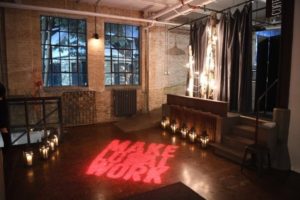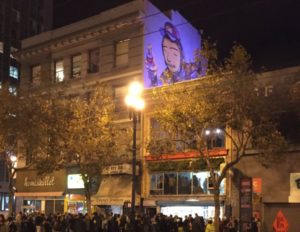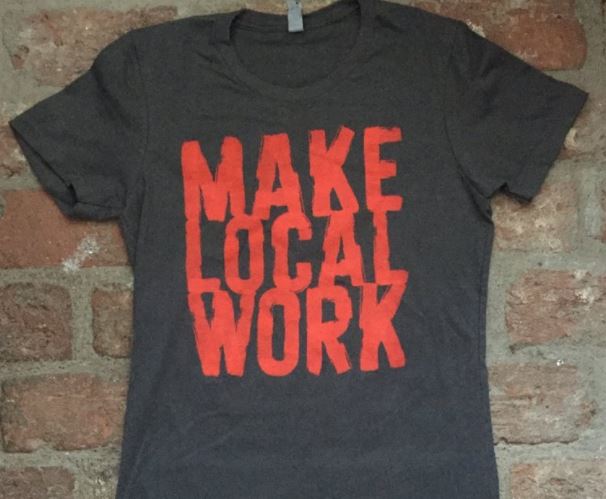Artists and arts organizations are changing the use of public space, knitting social fabric across difference, contributing to community resiliency, and improving the economies of cities across America. This work is concrete and measurable — and, increasingly, mayors, investors and philanthropists are partners to these efforts.
This was true three years ago, when I wrote the foreword to volume 10, issue 2 of the Community Development Investment Review of the Federal Reserve Bank of San Francisco, which focused on the role art and creativity play in local communities. It is even more true today.

Working with an affordable housing developer, Mellon helped create a sustainable film, television, and media economy in the Hudson Valley. Photo courtesy of Stockade Works.
Look at the housing, community facilities, and small businesses that community development finance institutions are investing in coast to coast, and it’s clear that creative places and creative businesses are a fundamental part of healthy, vibrant, sustainable communities.
In Trinidad, Colorado, nonprofit real estate developer Artspace is transforming an entire block on Main Street into artist live/work housing, a gallery, and flexible community space.
On Chicago’s South Side, the landmark Avalon Regal Theater will reopen this year, anchoring an innovation district with music studios and rehearsal facilities, retail, housing, an innovation/technology incubator, a film studio, and the new Museum of Black Music.
In Maine, Coastal Enterprises, Inc. is invested in American Roots and other specialty textile companies, activating historic mills and creating quality jobs connected to fashion and craft.
When the country’s top community development organizations look at how they have been investing their money, they realize a meaningful amount has gone to creative places and businesses. From 2004 to 2013, the Community Development Financial Institutions (CDFI) Fund of the US Treasury deployed $460 million through the New Markets Tax Credit Program into creative places and businesses.
Over the past 30 years, the Local Initiatives Support Corporation (LISC) has invested $138 million in grants, loans, or project equity in 98 projects (with a total cost of almost $1 billion) across the US. Community development organizations invest in these deals because they make financial sense, and because they create social impact for communities.
Research and experience have shown how the presence of creatives — artists, designers, makers — can stabilize threatened communities as well as benefit regions looking to attract and develop quality jobs. In April, my organization, Upstart Co-Lab, and Calvert Foundation released a report, Creative Places and Businesses: Catalyzing Growth in Communities, describing investible opportunities in the creative economy with the potential to benefit low-income communities over the next five years.
We identified a $1.54 billion pipeline of projects, which are representative of the potential of creative places and businesses. Here are some examples:
- Kingston, NY. Alongside a for-profit production studio and state-of-the-art sound stages, actor/director Mary Stuart Masterson is launching Stockade Works, a nonprofit education and training program, to create a sustainable media economy in the Hudson Valley. Stockade Works partners with RUPCO, a local provider of affordable housing and community development programs. Their motto is “Make Local Work.”
- Brooklyn, NY. ArtBuilt Brooklyn is a 50,000 square-foot affordable arts business production space located in the Brooklyn Army Terminal. Conceived in response to a wave of studio evictions that displaced hundreds of artists and creative organizations, ArtBuilt Brooklyn will offer long-term stability for the small producers in NYC’s creative economy.
- San Francisco, CA. The Community Arts Stabilization Trust (CAST) is a nonprofit real estate development and place-keeping organization that brings together private/public sector leadership and innovative financial vehicles to secure permanent space in urban city centers for community arts and culture organizations. By ensuring that these organizations have stable homes protected from a volatile real estate market, CAST enables arts entities to sustain the creativity and capacity necessary to promote lively and stable neighborhoods.
We are also seeing new approaches emerge that connect artists and communities funded by a combination of public and private capital. Our research has shown that inspiring creative places and businesses are actively pursuing operating models designed to be replicated in new communities.
- Nashville, TN. Former Blackstone partner Tom Middleton and country music legend T Bone Burnett are working in a public-private partnership with the city of Nashville to redevelop the 21-acre site of the former Greer Stadium. The plan includes a park, public open space and greenways; 300 units of affordable, workforce, and market-rate housing; plus restaurants and shops. The heart of the complex is an art and music generator open to the community.
- Phoenix, AZ. Artist and fourth generation farmer Matthew Moore has teamed up with third generation restauranteur Aric Mei to launch Greenbelt Hospitality. The concept puts a working, two-acre organic farm in an urban park; couples it with an affordable restaurant serving farm-to-table meals; and places education and art events at the core of the complex. Any city with public parkland can host this self-sustaining creative enterprise.
- Seattle, WA. Sculptor Samuel Farrazaino, runs Equinox Studios LLC, 100,000-square feet of affordable workspace for 125 artists and artisans, including blacksmiths, sculptors, painters, ceramicists, glassblowers, leatherworkers, woodworkers, and photographers. Equinox is a for-profit model designed to be replicable by any developer in any town, showing how it is possible to generate a six to eight percent return by making affordable workspace available to artists.
Creative people gravitate toward solving problems. That’s why artists and designers are founders of leading internet companies: from AirBnB and Crowdrise, to Kickstarter and Etsy. They are transforming where we stay, how we give, and how we create. But most artists work in place. They are our neighbors. And they are the neighbors you hope move in next to you.

A CAST project: The 509 Cultural Center is a nonprofit, artist-run, multidisciplinary arts organization, founded in 1987 by residents of the Tenderloin. Photo courtesy of CAST.
In St. Louis, De Nichols has started Civic Creatives to help citizens more creatively engage and address social topics that matter to them. Projects focus on public space, food and equity, conflict resolution, and youth. Nichols’ work uses storytelling, creativity, and technology to build connection and communication: “The more we build a community around being good to ourselves and reflecting on what’s happening in our lives and traversing through these issues, more people will find unity and commonality.”
All of the people and organizations I mention here have been touched over the last 50 years by the National Endowment for the Arts (NEA), whether by participating in arts education school programs; visiting museums, theaters, and concert halls; or reading books published by adventuresome small presses. The grants made through the NEA directly fund dance companies, jazz performances, art exhibitions and film festivals.
But the most important investment our federal arts agency makes is in our capacity as a society to innovate, to solve problems, and to be resilient. And nowhere is that more evident than in our communities.
This article by Laura Callanan originally appeared on the Mellon Foundation website. Reprinted with permission.
Featured image courtesy of Stockade Works.

